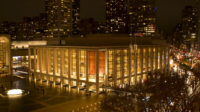The Learning Hub for Nanyang Technological University in Singapore opened early in 2015. Since Thomas Heatherwick conceived his puffy UK pavilion (known as the Seed Cathedral) for the Shanghai World Expo in 2010, his London-based firm, Heatherwick Studio, has been on a roll. Its design for a park on Pier 55 on the Hudson River in New York (funded mostly by Barry Diller, the head of IAC/InterActiveCorp) has attracted attention–and stirred controversy. Up the river, at the mixed-use Hudson Yards project, Related Properties plans to enliven the public space with a 'monumental sculpture' by Heatherwick (details to come). Recently, Heatherwick and the Danish architect Bjarke Ingels of BIG have teamed up to design Google's headquarters in Mountain View, California. Heatherwick is also working with Foster + Partners on the Bund Finance Centre in Shanghai, currently under construction.
And, now until January 3, the retrospective exhibition Provocations: The Architecture and Design of Heatherwick Studio is on view at the Cooper Hewitt, Smithsonian Design Museum in New York. Curated by Brooke Hodge, the show was organized by the Nasher Sculpture Center in Dallas in 2014, then moved to the Hammer Museum in Los Angeles before arriving in New York. Heatherwick spoke to RECORD just before the exhibition opened on June 24.
Architectural Record: Your designs embrace an impressive range of work–sculpture, architecture, infrastructure, urban design, interiors. Yet they vary greatly in style: you wouldn't walk into the sleekly luxurious Longchamps store in Soho and say, 'Oh, that's a Heatherwick.' And the same goes for London's quirky Rolling Bridge (2004), or the streamlined New Routemaster bus (2012).
Thomas Heatherwick: We never try to have a style; we analyze the place and invent a solution for it. We want to rethink the problem. For example, with the cauldron commissioned for the 2012 London Olympic Games, we were motivated by the way it was lit. It led us to create 204 small copper artifacts, each with a flame, which formed one giant kinetic sculpture. We wanted the cauldron to mean something to so many people coming together.
So much of your work is architecture, including the organically curvilinear concrete Learning Hub for Nanyang Technological University in Singapore, which opened this year. Yet you are not an architect.
Of the 170 people we have in the studio, 114 have architectural training. I studied three-dimensional design–in wood, metal, and plastic–at Manchester Polytechnic [now Manchester Metropolitan University], which helped greatly in my approach to architecture. At the Royal College of Art [where Heatherwick got an M.A.], I soon realized the benefits of collaboration.
How does that feed into your creativity?
Creativity is not a solo thing'it's collaborative. Every project, from a power station to a London bus to a part of the city, is something we methodically research and analyze.
Then how do you arrive at a solution?
For me, there is no clichéd notion of inspiration. I resist even the word inspiration. Everything is solving problems, but you need to believe in the problem. And you need to ask, is this the right question? If you figure out the real question, that's the provocation'you are almost there with the solution. It's like solving a crime: you investigate clues to get to the real answers; you narrow down the inquiry by seeing what you should and shouldn't be doing. At some point, you say, 'That's it!' It is through discussions you come to that moment.
What about the varied scale of your projects? Many architects can't easily leap from a piece of furniture to a skyscraper.
Bigness has a smallness: ideas don't really have a scale.
What else do you need to come up with ideas?
You have to have passion, stamina, and optimism.










Post a comment to this article
Report Abusive Comment